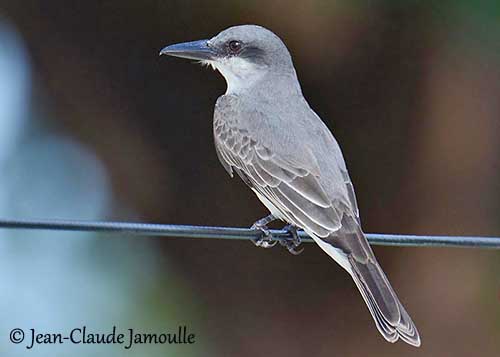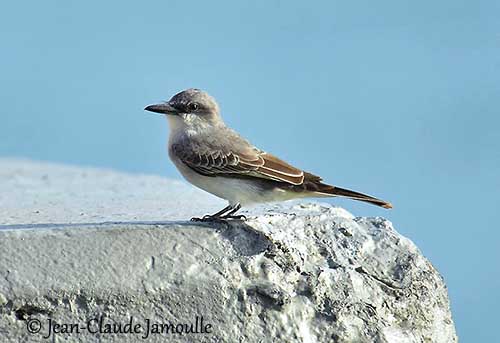
Fr: Tyran gris
Ang: Grey Kingbird
All: Grauer Königstyrann
Esp: Tirano Dominicano - Pitirre
Ita: Tiranno di Dominica
Nd: Grijze Koningstiran
Sd: Grå kungstyrann
Photographers:
Alfredo Colón
Puerto Rico Wildlife
Jean-Claude Jamoulle
A la rencontre des Oiseaux
Text by Nicole Bouglouan
Sources:
HANDBOOK OF THE BIRDS OF THE WORLD Vol 9 - by Josep del Hoyo - Andrew Elliot - David Christie - Lynx Edicions - ISBN: 8487334695
A GUIDE TO THE BIRDS OF COLOMBIA by Steven L. Hilty and William L. Brown - Princeton University Press – ISBN 069108372X
BirdLife International (BirdLife International)
What Bird-The ultimate Bird Guide (Mitchell Waite)
Wikipedia, the free encyclopaedia
Grey Kingbird
Tyrannus dominicensis
Passeriformes Order – Tyrannidae Family
INTRODUCTION:
The Grey Kingbird belongs to the family Tyrannidae, subfamily Tyranninae. This large flycatcher is also known as Pitirre. It is strongly territorial and becomes aggressive while defending its area against intruders, even larger ones. The Grey Kingbird has become the nationalist symbol in Puerto Rico for this behaviour.
DESCRIPTION OF THE BIRD:
Biometrics:
Length: 21-25 cm
Wingspan: 37-40 cm
Weight: 44-47 g
The adult has pale to dark grey upperparts with brownish-black upperwing. Wing-coverts and flight feathers are narrowly edged whitish. The notched tail is mostly dark brown or blackish. The uppertail-coverts are blackish with brownish edges.
On the underparts, chin and throat are white. Rest of underparts is whitish with greyish wash on breast, and pale yellowish wash on belly and vent.
On the dark grey head, the crown shows dusky narrow streaks. There is a yellow-orange, orange or red, semi-concealed median stripe. Lores and ear-coverts are blackish, forming a conspicuous dark mask.
The large, heavy bill is fairly long and black. The eyes are dark brown. Legs and feet are black.

Both sexes are similar, except the crown patch which is smaller in female.
The juvenile has browner upperparts with cinnamon margins on wing-coverts, rump and tail. The crown patch is absent.
SUBSPECIES AND RANGE:
The Grey Kingbird has two recognized subspecies.
T.d. dominicensis (described and displayed) breeds in SE USA, Bahamas and Greater Antilles, locally in NC Venezuela, Trinidad and Tobago, Curaçao, Bonaire and possibly N Colombia.
It winters from Panama, S to C Colombia and S and E Venezuela.
T.d. vorax (displayed) is found in the Lesser Antilles.
This race is larger than nominate, and slightly darker, with larger bill.
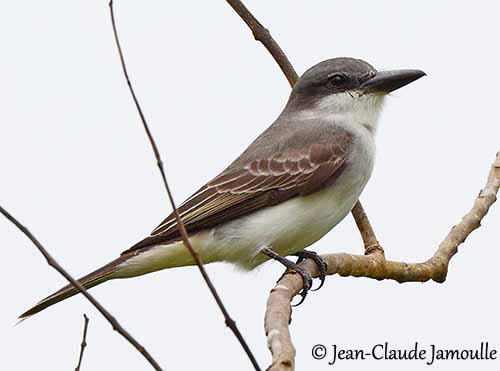
HABITAT:
The Grey Kingbird is a bird of open and semi-open areas with some scattered trees and bushes. It occurs near water in coastal areas, open woodland with pine and oak, forest edges, grassland, cultivated areas and pastures, parks and towns. It can be seen locally on mangrove borders.
It is usually seen below 500 metres, but in Venezuela, it occurs up to 1700 metres of elevation, and between 2500 and 3000 metres in the Andes of Colombia.
CALLS AND SONGS: SOUNDS BY XENO-CANTO
The Grey Kingbird gives rolling, throaty “pe-cheer-ry” with more accentuated second syllable. The common call is a shrill, emphatic “pit-piteerri-ri-ree” and variants. The dawn song by the male is a variation of the call, six more musical notes “pi-ti-reee-pi-ti-rro” and some other sharp sounds.
The courtship displays are accompanied by bill-snapping and wing-whirring.
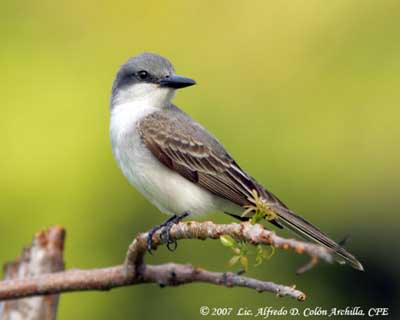
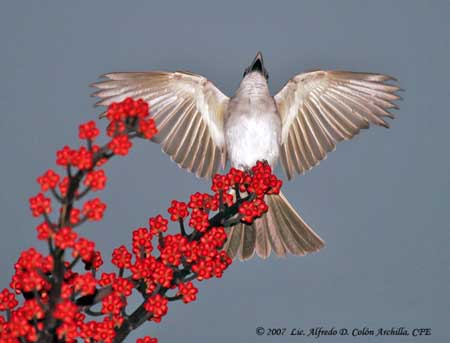
BEHAVIOUR IN THE WILD:
The Grey Kingbird feeds mainly on insects such as beetles, wasps, bees and large flying insects as large as dragonflies. It also takes some spiders. It may occasionally catch small lizards and small fish. The large preys are beaten against the perch before to be swallowed. According to the season, it consumes berries and small fruits.
It forages in typical flycatcher fashion, with sallies from exposed perches such as wires, fences and bushes from where it watches for preys. Other items and insects are taken from the foliage.
It can be seen alone or in loose flocks.
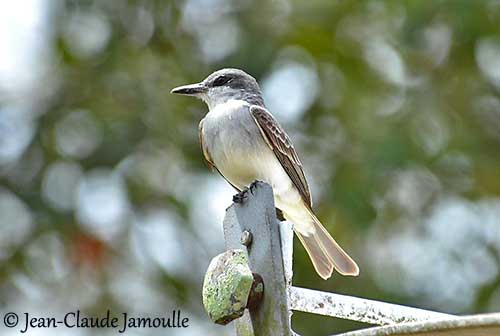
The Grey Kingbird is strongly territorial and defends the nest even against large intruders and humans coming too close.
The displays are poorly known, but we can suggest that the brightly coloured crown patch is exposed by adapted postures, while spreading the wings repeatedly. Both mates also perform aerial displays, crossing one another while ascending straight upward or spiralling. We can hear loud calls and bill-snapping.
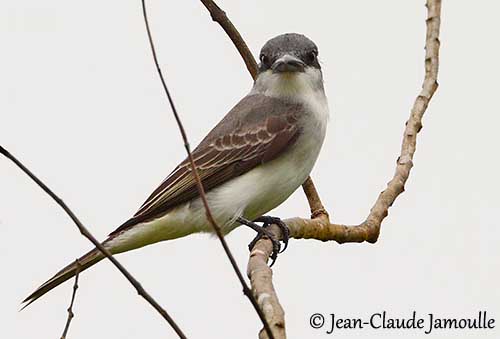
The Grey Kingbird of nominate race migrates from Panama, S to C Colombia and S and E Venezuela. They may venture further inland in their wintering areas and during migrations.
The direct flight is buoyant and fluttering, performed with shallow wingbeats.
REPRODUCTION OF THIS SPECIES:
The breeding season varies, depending on the range, but it usually occurs between April and July.
The female builds a flimsy cup-shaped structure with grass, twigs, roots, stems and vines. The interior is lined with softer grasses, moss and rootlets, and sometimes hair. It is placed in fork or on top of horizontal tree branch, or in shrub or artificial structure, usually between 1 and 6 metres above the ground, sometimes higher and mainly in mangroves.
The female lays 3-5 (often 3) pink to buff eggs with coloured markings. The incubation by female lasts 14-15 days. The chicks are fed on small and large insects by both parents. They leave the nest about 16-18 days after hatching, but they still depend on adults for some weeks more, usually 3-5 weeks after fledging.
The nest can be sometimes parasitized by the Shiny Cowbird and the Brown-headed Cowbird, but these attempts are infrequent and probably unsuccessful.
PROTECTION / THREATS / STATUS:
The Grey Kingbird is common in its range. However, use of pesticides, hunting, collisions with vehicles and degradation of coastal habitat may affect the species. The population is currently stable and estimated at 780,000 individuals.
The Grey Kingbird is evaluated as Least Concern.
